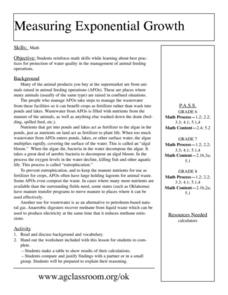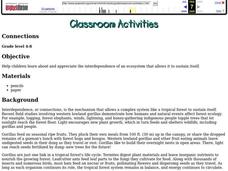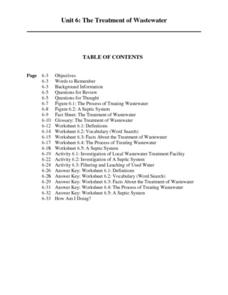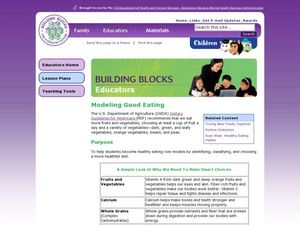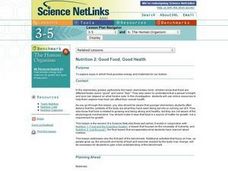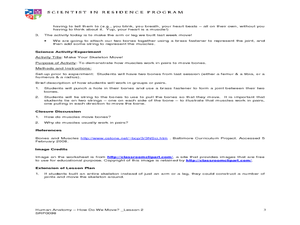Curated OER
Earthworm Animation
Students use animation to create their own earthworm catching and eating its prey. They must draw storyboards before they start on the animation.
Curated OER
Measuring Exponential Growth
Middle schoolers reinforce math skills while learning about best practices
for protection of water quality in the management of animal feeding
operations. They make a table to show results of their calculations and compare and justify...
Curated OER
Hunger and Malnutrition
Young scholars recognize that our bodies cannot function without certain essential foods. In this hunger and malnutrition lesson, students become familiar with the problems associated with malnutrition such as medical problems, problems...
Curated OER
CONNECTIONS
Students study the interdependence of an ecosystem that allows it to sustain itself. They examine the Western lowland gorillas for an example.
Curated OER
Those Amazing Earthworms- A Worm's World
Students investigate earthworms. In this organisms lesson, students observe earthworms in their environment and record their behavior towards light and how they eat. Students continue on a month long observation.
Curated OER
Hand Writing: Three Letter Words
In this printing practice worksheet, students trace, form, and print three letter words. Students practice printing ten separate words.
Curated OER
They Don't Just Eat Grass
Students consider the USDA daily recommendations to create a "feed" product for middle schoolers. In this Health lesson, students learn about the ingredients in feed that is fed to livestock and apply the method to creating feed rations...
Curated OER
Worm Composting
Second graders discuss worm composting. In this decomposition lesson plan, 2nd graders look at the anatomy of the worm and how it eats food. They have their own worm bin and review what foods can and can not be given to the worms for...
Curated OER
Carbohydrates-Simple and Complex
Grain products are staple foods and sources of simple and complex carbohydrates that provide energy for the body. Define simple and complex carbohydrates Identify function and sources of simple and complex carbohydrates Describe how...
Curated OER
The Treatment of Wastewater
Students, through a series of lessons, study the various processes of treating wastewater. They participate in discussion and complete various worksheets and a hands-on activity, in which they observe the processes of filtration and...
Curated OER
Translating Genetic Information
Students explore the process of translation. They determine the correct sequencing and present their strands to the class. In addition, they compare normal red blood cells to sickle cells and complete discussion questions.
Curated OER
A Tough Nut to Crack
Children, based on a set of criteria, evaluate the quality of pecans. They research recorded history of pecan trees as well as how their seeds moved across western Missouri into southeastern Kansas, Oklahoma, Texas and Mexico. In...
Curated OER
Carbohydrates and Fats Crossword
In this carbohydrates and fats instructional activity, students complete a crossword puzzle by figuring out the vocabulary words associated with 19 clues given.
Curated OER
Diffusion Through a Membrane
In this diffusion through a membrane worksheet, students fill in the blanks to complete 27 statements about cell membranes, the movement of molecules across the cell membrane, concentration gradients and diffusion.
Curated OER
Modeling Good Eating
Students identify and classify the items in a healthy diet. In this dietary lesson, students listen to a song about healthy eating while listening for good snack foods. They use pictures of the snacks to complete a large chart by...
Curated OER
Computation: How can we use rice to solve problem questions?
Fourth graders graph metric tons of rice produced by various countries. In this graphing instructional activity, 4th graders follow problem solving steps to answer questions about rice nutrition and then graph the amount of rice...
Curated OER
Planets in a Bottle
Students experiment with yeast. For this environmental conditions lesson students test the viability of samples of yeast. Students investigate the effects of environmental conditions on the yeast.
Curated OER
A Tough Nut to Crack
Sixth graders explore agriculture by examining world geography. In this pecan cultivation lesson, 6th graders identify the history of the famous nut and the impact it has on the U.S. economy, diet and human body. Students define...
Curated OER
Good Food, Good Health
Learners investigate how food provides energy for the human body. In this physical health instructional activity, students access online resources to identify how certain foods can affect their health. Learners discuss how many servings...
Curated OER
Water
Students conduct a series of investigations on the unique properties of water. In this general science activity, students explain what causes water's surface tension. They explain the different stages in the water cycle.
Curated OER
The Skeletal System
Young scholars research the skeletal system. In this anatomy lesson, students measure their bodies to find the approximate length of their bones. They draw and cut out each of the bones and then attach them using brads or glue.
Curated OER
Human Anatomy- How Do We Move?
Students examine the muscular system. In this muscular system instructional activity, students first draw a realistic representation of their leg or arm bones. Students do several activities to attach these bones to "joints" with...
Curated OER
Human Anatomy - How Do We Move?
Fifth graders discover how blood moves around the body. In this circulatory system lesson, 5th graders feel their pulse before and after exercise. Students count their heart rate. Students use the scientific method to record...
Curated OER
Nutrition 3: Got Broccoli?
Students discover why the human body needs food in order to survive. In groups, they analyze advertising for the foods they eat the most and try to identify the nutritional value of them as well. They complete a worksheet showing them...

